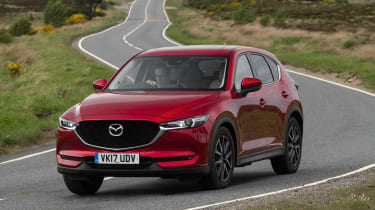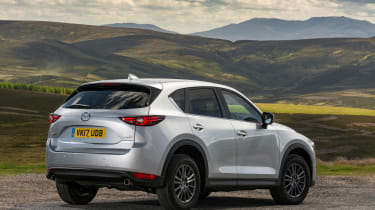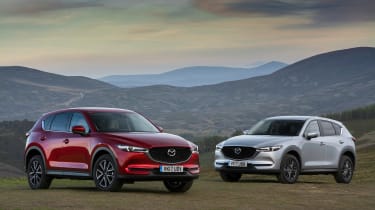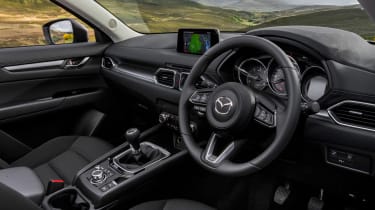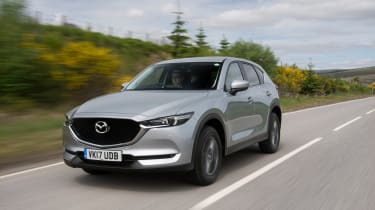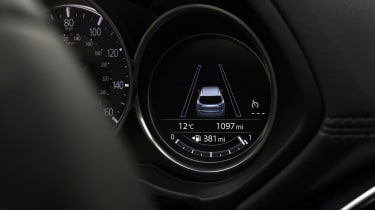2017 Mazda CX-5 review - the driver's choice in the SUV market?
A whole host of small but significant changes have improved the CX-5. Not the most spacious, but a top choice for keen drivers
When it made its debut in 2012, the Mazda CX-5 proved to be a big hit for the Japanese brand. With its blend of engaging handling, rugged off-roader styling cues and practical interior, the high-riding compact SUV proved that driving fun and the fashion for 4x4s didn’t have to be mutually exclusive.
Fast-forward five years and there’s an all-new CX-5, but Mazda has tried not to mess with the winning formula. The styling changes help give the car a sleeker look, but the proportions and detailing will be familiar to owners of the old model.
It’s a similar story inside, where the pursuit of premium sees greater use of soft touch plastics and brushed metal trim, but it’s draped over existing architecture. However, while that means the cabin feels more upmarket, it’s barely any bigger than before. This means that when it comes to practicality, the CX-5 is class competitive rather than class leading – buyers looking to edge ahead in the space race should look to the Skoda Kodiaq instead.
Under the bonnet it’s business as usual, with the same 2.0-litre petrol and 2.2-litre diesel units carried over largely unchanged. Power outputs are the same, plus the choice of six-speed manual and auto gearboxes, plus front or four-wheel drive is as before.
More reviews
Group tests
- Lotus Emira Turbo SE v Alpine A110 GTS – two of the last surviving mid-engined sports cars
- Alpine A290 v Alpine A110 – how much DNA do they really share?
- Ariel Atom 4R v Caterham Seven ‘evo25’: power-to-weight heroes go head-to-head
- Ariel Atom 4 v Caterham Seven 310R v Lotus Elise Cup 250
- £200,000 supercar shoot-out: AMG v Aston Martin v Maserati v McLaren
- Audi Quattro, RS2 and RS3: five-cylinder icons head-to-head
- Who makes the best GT car? Aston Martin v Bentley v Maserati
- Caterham Super Seven 600 v Super Seven 2000
- Corvette Stingray v Porsche Cayman GTS v Audi R8 RWD
- Great Ferrari hypercars driven: 288 GTO, F40, F50 and Enzo head-to-head
In-depth reviews
- Abarth 600e 2025 review – Italy gives the Alpine A290 something to worry about
- Alpine A110 review – the sports car Lotus should be building
- Aston Martin Vantage 2025 review – a thrilling Mercedes-AMG GT and 911 Turbo S alternative
- Audi R8 (2015 - 2024) review – the ultimate soft-focus supercar
- Bentley Flying Spur review – the ultimate driver’s limousine
Long term tests
- Abarth 695C Turismo Fast Fleet test – living with the charming Italian hatch
- Alfa Romeo Giulia Veloce long term test – can Italy beat Germany?
- Alpina B10: Alpina B10: end of term report
- Aston Martin Vantage (2006) Fast Fleet test – living with a £30k V8 Aston
- Caterham Seven evo25 Fast Fleet test – living with a track car for the road
- Caterham Seven evo Edition revealed – bespoke 420R joins the Fast Fleet
- Cupra Leon 300 Fast Fleet test – living with Spain's 300bhp hot hatch
- Cupra Ateca VZN Fast Fleet test – four months with Cupra's hot crossover
- Cupra Leon Estate 310 4Drive Fast Fleet test – living with the 306bhp hot estate
- Ford Mustang GT
Review
- New Bentley Batur 2023 review – can it possibly be worth £1.65m?
- 2023 Chevrolet Corvette C8 Z06 review – the American 911 GT3?
- BBR Supercharged Mazda MX-5 (ND) 2023 review – tuned 250bhp roadster driven
- MG4 Trophy 2023 review
Reviews
- Abarth 695 75 Anniversario edition 2024 review – a fitting send-off for Abarth’s hot supermini?
- Abarth 500e 2023 review
- AC Cobra 378 Superblower MkIV 2021 review – another V8 Cobra, but with a GM heart this time
- Acura Integra Type S 2024 review – a Honda Civic Type R with added restraint
- Alfa Romeo Giulia review – get one while you still can
- Alfa Romeo 33 Stradale 2025 review – a rare Italian jewel beyond compare
- Alfa Romeo SZ: history, review and specs of an icon
And like the 6 saloon and 3 hatchback, the CX-5 now gets the brand’s G-Vectoring, which uses the engine rather than the brakes to create a torque vectoring effect.
Also similar is the platform, which features the same basic structure and 2,700mm wheelbase as the old machine. However, higher strength steels have been used to boost torsional rigidity, while the suspension has been thoroughly overhauled in an effort to further improve ride, handling and refinement.
Technical highlights
Perhaps the most intriguing aspect of the Mazda’s mechanical make-up is its G-Vectoring system. It’s already been seen on the 6 saloon and 3 hatchback, but this is the first time it has been applied to an SUV.
Essentially it’s a torque vectoring system, but unlike rival systems it doesn’t use the brakes to sharpen turn-in and dial out understeer. Instead, it subtly reduces engine torque as you turn the wheel, momentarily decelerating the car and shifting the weight forward and over the front tyres for increased grip.
As with all Mazda models, the CX-5 has been developed around the firm’s SkyActiv philosophy. This effectively means engineers have strived to make the car as light, efficient and fun to drive as possible.
In the case of the CX-5, the use of the old car’s platform means the kerbweight is largely unchanged, but increased use of high tensile steel means that torsional rigidity has been boosted by 15 percent.
Work has also been undertaken on the suspension, with the strut front and multi-link rear benefitting from plenty of revisions. The biggest changes revolve around new dampers with revised valving and the use of liquid filled bushes for greater accuracy and reduced vibration.
Our test car was also fitted with the brand’s latest four-wheel drive system, which is standard fit on the 173bhp diesel and optional on the lower powered 148bhp version. Called i-ACTIV AWD, it uses 27 sensors to monitor everything from throttle application, yaw and steering inputs to decide how best to distribute the engine’s torque. Even switching on the windscreen wipers will subtly adjust the set-up as it primes itself for wet and slippery conditions. It’s all very clever.
Engine, transmission and 0-62mph time
There’s a choice of 2.0-litre petrol or 2.2–litre diesel engine, but it’s the latter that’s most popular – and the one we test here. As before, it’s available in either 148bhp or 173bhp guises, but subtle changes to the internals aim to make it quieter and more refined.
Some of these gains have been made with improved sound insulation, but there’s also a device that Mazda calls the Natural Sound Smoother, which consists of a special damper that sits within the engine’s connecting rod pin. It’s a small change, but it’s remarkably effective.
At idle the more powerful iteration of the 2.2-litre unit emits nothing more than a muted clatter, while under load the soundtrack is more petrol than diesel. It’s not exactly exciting, but the distant growl does make you second-guess the type of fuel that’s being used.
The four-cylinder powerplant also responds more crisply to the throttle than most diesels, plus it revs with impressive keenness. Outright performance isn’t anything to write home about, with 0-62mph coming up in 9.0 seconds, but in the real world it feels stronger than the figures suggest. This is largely down to the thumping 310lb ft that’s delivered at just 2,000rpm.
Accessing the engine’s potential is made easier by the standard six-speed manual, which benefits from slick and precise shift action - there’s the spirit of the MX-5 roadster in this transmission.
What’s it like to drive?
Mazda places great emphasis on its ‘Jinba Ittai’ philosophy. The literal translation has something to do with horses and riders, but the brand has reappropriated the phrase and changed the meaning to ‘car and driver as one’.
Now, you can see where this driver-centric approach would work with the MX-5, or even one of the firm’s front-wheel drive hatches, but can it really be successfully applied to an SUV?
Surprisingly, the answer is yes. If you’re in a position where you have no choice but to drive a compact off-roader that’ll spend most of its time on tarmac, then the CX-5 should be close to the top of your shortlist.
From the moment you pull away, it’s clear this machine has been developed by the same team that created the MX-5. Obviously you sit much higher and the view out is rather different, but the driving position is spot on and the major controls have the same perfectly judged weighting.
Point the CX-5 down some typically twisted and torn back roads and it responds remarkably well. The steering is precise and has a natural rate of response, making it easy to place the car exactly where you want it. There’s also more grip to lean on than you’d expect, so you can push harder than you’d dare in other similarly high-riding models.
More surprising is the excellent body control. Yes there’s some roll through tighter corners, but it’s only when travelling quickly on really ragged roads that the Mazda starts to get a little flustered. Even then, the CX-5 never feels wayward; it merely gently reminds you that this is a tall vehicle that tips the scales at nearly 1,700kg in diesel all-wheel drive guise.
The CX-5 also gets the slickest application yet of Mazda’s G-Vectoring system. Unlike in the 6 saloon and 3 hatchback where you’re aware of the engine subtly throttling back the torque, in the CX-5 the set-up is seamless, with the driver’s only clue to its effectiveness is unusually strong front end bite when turning in.
And it’s not just the chassis’ composure in corners that marks the Mazda out as a surprisingly engaging choice. The pedals are perfectly spaced, while the brakes are progressive and offer decent stopping power. The CX-5 also smothers bumps well, avoiding the stiff-legged low speed ride that often affects cars like this. Factor in the decent suppression of wind and road noise, and the Mazda makes for refined and relaxed progress when all you want to do is take it easy.
Price and rivals
Prices for the Mazda start at £23,695 for the entry-level front-wheel drive petrol, while the 2.2 D 175 AWD Sport Nav driven here weighs in at £31,395. That looks a little expensive until you consider that a similarly equipped VW Tiguan 2.0 TDI 150 R Line 4Motion will set you back a not inconsiderable £34,360. By contrast, the more practical seven-seat Skoda Kodiaq 2.0 TDI SE L undercuts the Mazda at £30,800. And while it’s not quite as engaging to drive, it’s close enough that some will sacrifice the sliver of extra satisfaction behind the wheel for the increase in space.
